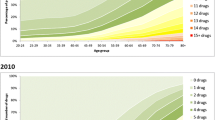Abstract
Objectives: To describe a simple method for assessing the quality of drug prescribing. Methods: We tested the idea that the number of drugs accounting for 90% of drug use – drug utilization 90% (DU90%) – may serve as an indicator of the quality of drug prescribing. We ranked the drugs by volume of defined daily doses (DDD) and determined how many drugs accounted for the DU90% segment. We also compared this segment with the pharmacotherapeutic guidelines issued by the Regional (local) Drug Committee to determine the adherence to its recommendations (index of adherence). The cost per DDD within the DU90% segment and for the remaining 10% was also calculated. The utilization of drugs based on prescriptions purchased during April 1995 was determined for 24 primary health care (PHC) centres in southwestern Stockholm. Results: The number of different products, defined as all products marketed under a single brand name within an ATC (anatomic therapeutic chemical) category, in the DU90% segment varied twofold (81–164) between the 24 PHC centres. Differences in the number of GPs per PHC centre accounted for a third of this variation. The compliance with the Drug Committee recommendations varied between 54% and 78%. There was no relationship between the number of products accounting for the DU90% segment and the adherence to local prescription guidelines, i.e. prescribing more products did not increase the adherence.
The costs for the DU90% drugs varied from 2.26 SEK/DDD in one PHC centre to 3.75 in another one, with an average cost of 2.87 SEK/DDD, while for the remaining 10% it was the double (6:54 SEK/DDD). In all, the DU90% drugs made up 80.8% of the total cost as compared with 19.2% for the remaining 10%. In the DU90% segment, there was no clear relationship between adherence to the guidelines and the cost/DDD, i.e. following the evidence-based guidelines appeared to provide a higher quality of prescribing rather than cheaper prescribing.
Conclusions: The DU90% is an inexpensive, flexible, and simple method for assessing the quality of drug prescribing in routine health care. The number of products in the DU90% segment and adherence to prescription guidelines may serve as general quality indicators. The method may be adapted to provide comparative data between PHC centres, hospitals, regions etc. that may be cross-sectional and longitudinal. Other quality criteria, specific for each class of drugs, should complement these general indicators.
Similar content being viewed by others
Author information
Authors and Affiliations
Additional information
Received: 29 August 1997 / Accepted in revised form: 11 December 1997
Rights and permissions
About this article
Cite this article
Bergman, U., Popa, C., Tomson, Y. et al. Drug utilization 90% – a simple method for assessing the quality of drug prescribing. E J Clin Pharmacol 54, 113–118 (1998). https://doi.org/10.1007/s002280050431
Issue Date:
DOI: https://doi.org/10.1007/s002280050431



